

EXHIBIT CLOSED
~~~~~~~~~~~~~~~~~~~~~~~~~~~~~~~~~~~~~~~~~~~~~~~
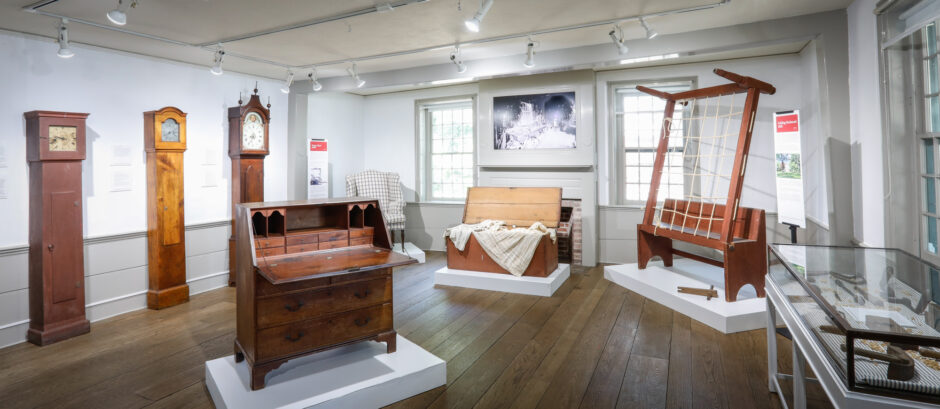

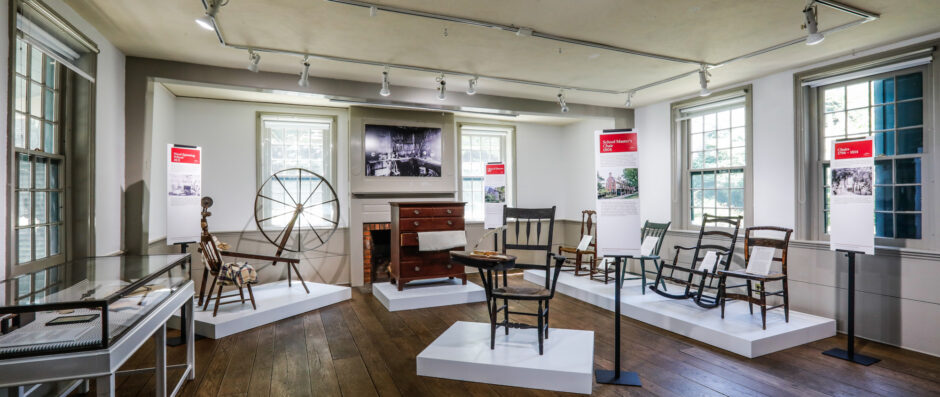
~~~~~~~~~~~~~~~~~~~~~~~~~~~~~~~~~~~~~~~~~~~~~~~
Dominy Craftsmen and Their Customers 1760 – 1840
The Dominy family of craftsmen—Nathaniel Dominy IV (1737- 1812), his son Nathaniel Dominy V (1770-1852), and his son Felix Dominy (1800-1868) — father, son, and grandson — worked from about 1760 to 1840 when the last entries for making furniture were posted in their account books. From their home and workshop on North Main Street in East Hampton, they completed hundreds of custom commissions ranging from cradles to coffins, wooden buttons to watch repair, clocks, fine furniture, and even the 1806 Hook Windmill still standing at the north end of Main Street.
Often working for barter, they were self-taught artisans in a family apprenticeship system and even made many of their own tools. Their well-documented craftsmanship tells a unique story of day-to-day colonial life. They were renowned not just in East Hampton, but throughout Long Island and even the Northeast. By 1820, the Dominys’ business dropped sharply when their prices could not compete with newly available machine-manufactured goods. In 1835, Felix closed the business to take a job as a lighthouse keeper on Fire Island.
By 1946, the Dominy home had become derelict. The house was demolished and the workshops repurposed elsewhere in East Hampton. Their 1,100 tools were acquired by Winterthur Museum located just outside Wilmington, Delaware, where they are still on display.
When the house was demolished, the original woodworking and clock shops were preserved by Dudley Roberts and moved to his property on Further Lane. In 2016, the shops were gifted to East Hampton Village, which committed to reconstruct the Dominy family home on its original foundation on North Main Street.
Opening this summer, the Dominy Shops Museum
will be operated by the East Hampton Historical Society.
~~~~~~~~~~~~~~~~~~~~~~~~~~~~~~~~~~~~~~~~~~~~~~~

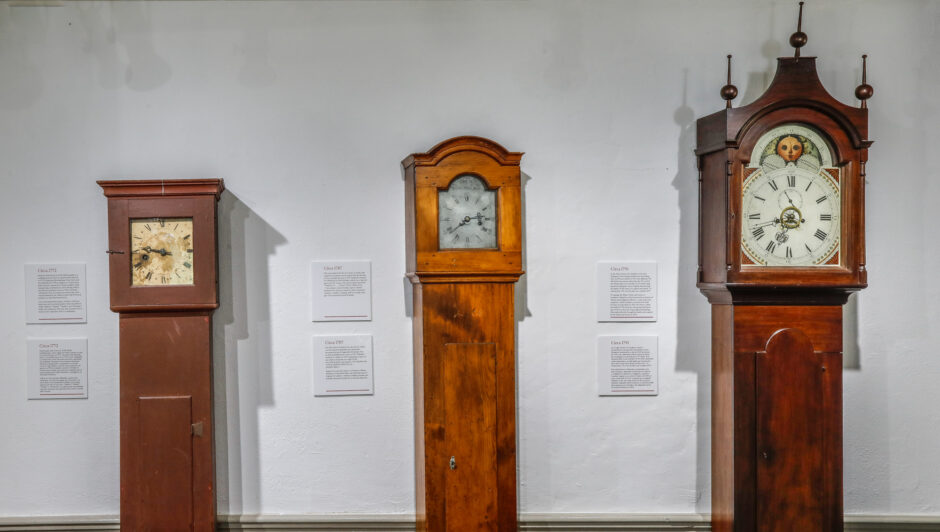
Tall Case Clocks
Dominy account books indicate that 90 or more tall case clocks were produced between 1768 and 1828. More than 50 survive. By 1828, the competition from less expensive Connecticut-made clocks with wooden works had all but put an end to a century old family tradition.
Clock leftside: Tall Case Clock, 1772 — Made for John Davis Jr. (1748 – 1809) possibly as a wedding present when he married Puah Parsons in 1772. During the Revolutionary War, Davis and his family fled in 1778 as refugees to Connecticut. John was later captured by Hessian soldiers while transporting contraband in a boat off Sag Harbor and died as a prisoner of war in 1781. His family continued to live in Connecticut where this clock was purchased by the collector John Hall Wheelock and given to the Historical Society.
Clock center: Tall Case Clock, Circa 1787. This year marked the first in a series of clocks with engraved inscriptions preoccupied with the fleeting of time, possibly because in 1787 Nathaniel Dominy IV celebrated his 50th birthday, which was a ripe old age in the 18th century. The pewter dial is inscribed, “TIME IS: IT _ _ _ FLIES: ANON, TIME WAS _ _ _ “. According to noted Dominy expert, Charles Hummel, the clock was made for either Captain H. Latham or Nathan Conkling. Still in working order, gift of the Raymond Smith III family.
Clock rightside: Tall Case Clock, 1791. In the 18th century, the Gardiners were East Hampton Town’s largest landowners (including their 3,300-acre island). In 1791, this elaborate 8′ tall clock was custom ordered by the 7th Lord of the Manor John Lyon Gardiner (1770 – 1816) using import mahogany and an English dial showing the phases of the moon. It is signed and dated: “N. Dominie fecit 1791, Novr for John Lyon Gardiner $ 70”. In 1947, the Gardiner Manor House, built in 1774, burned to the ground and this is one of the very few surviving original furnishings. Descended directly through the family and acquired by the Historical Society in 2021.

————
Slant-Front Desk, 1806
The hand-written pencil inscription on the underside of a drawer reads: “Nathaniel Domine Jun fecit Jan 1802 – For John Lyon Gardiner Esq – Price 27$ — 50 cts”. Two years after purchasing this desk, John Lyon Gardiner (1770-1816) was among the sponsors who commissioned Nathaniel Dominy V to build Gardiner Mill located at 36 James Lane. Six desks are recorded in the Dominy accounts. The construction is unusual because the fall-front lid is supported by iron rods and chain lengths, eliminating the need for sliding rests underneath. The Dominys were masters at simplifying design which saved time and materials.
This desk descended directly through the Gardiner family for over 200 years and was acquired by the Historical Society in 2021.
————
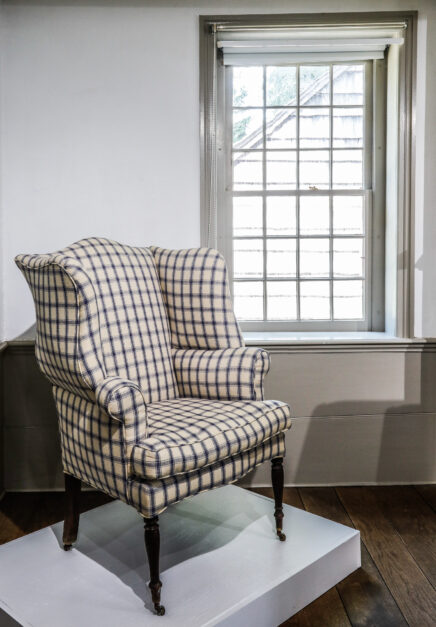 Wing Chair 1808
Wing Chair 1808
Originally made for Lieutenant Thomas Baker (1742-1825), a shoemaker who served in the American Revolution, the protruding “wings” protected the sitter from drafts and gathered the heat when pulled by the fireside. It was reserved for the most important member of the household. Since textiles were very costly in the 18th and early 19th centuries, this was an uncommon piece of furniture in East Hampton. The current checked wool covering on the chair is a replacement based on remnants of the original ticking. It would have been stuffed with horsehair and straw.
Serving as Lieutenant to Colonel David Mulford—who lived at the Historical Society’s Mulford Farm—during the Revolutionary War, Baker fled to Connecticut as a refugee and returned to Long Island in 1782.
Gifted by John Hall Wheelock and generously restored by Mrs. Elizabeth Gerschel.
——————————————-
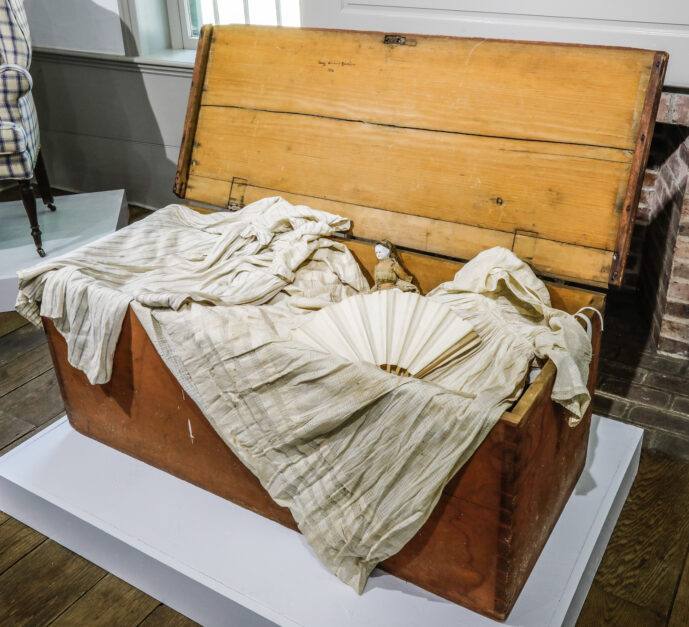
Travel Trunk 1816
Before roller bags, travelers packed their belongings in custom made trunks. Ordered by John Lyon Gardiner (1770—1816), the 7th Lord of the Manor of Gardiners Island, this trunk is inscribed by his granddaughter as “Mary Brainerd Gardiner’s 1816” and was used by her when she was sent away to finishing school at the age of 7 (her grandfather had died that year and she was now an heiress.) Never married, Mary was 24 when she died in 1833.
This trunk was rescued by an astute forager at the East Hampton Town Dump who brought it to the Historical Society. The side brackets are for looped rope carrying handles.
——————————————-

Folding Bedstead 1818
With large families and small houses, space was at a premium and called for practical solutions such as this early “murphy bed” that was only made up at bedtime (and often shared.) The mattress was a rope lattice that was topped by quilts stuffed with straw, chaff , or down feathers. The rope springs were occasionally tightened with the “bed key” shown, the origin of the phrase “sleep tight.”
Made by Nathaniel Dominy V for Abraham Sherrill Jr. (1754-1844) and described as “a bedsted with a joint to turn up £1-8-0.” The headboard doubled as a bench. Not only did the Sherrill family occupy their home, their farmworkers lived on the upper floors.
——————————————-
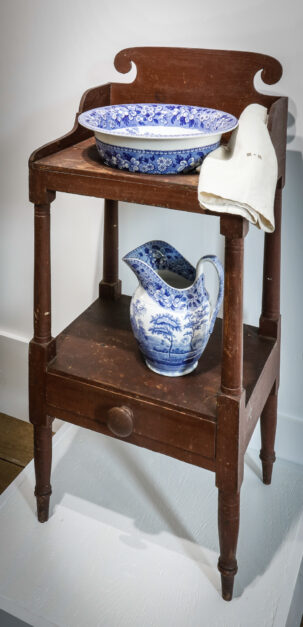
Washstand, 1809
A washstand provided the only indoor plumbing throughout most of the 18th and 19th century. A basin was filled by a pitcher of water to wash your hands and face. The resulting “slops” were then simply tossed out a window or door. This washstand was made at a cost of 10 shillings for Jonathan Mulford (1770 –1840) who lived at Mulford Farm on James Lane, which the Historical Society currently preserves and interprets.
The rams-horn crest on the rear panel of the splash board and the turned columns, legs and feet are an attempt to turn a utilitarian piece of furniture into something decorative. While the stand is made of pine, the brown paint covering a red stain was used to make it look like a more expensive wood.
Harrison Mulford, donor of this washstand, was the last resident of Mulford Farm.
——————————————-
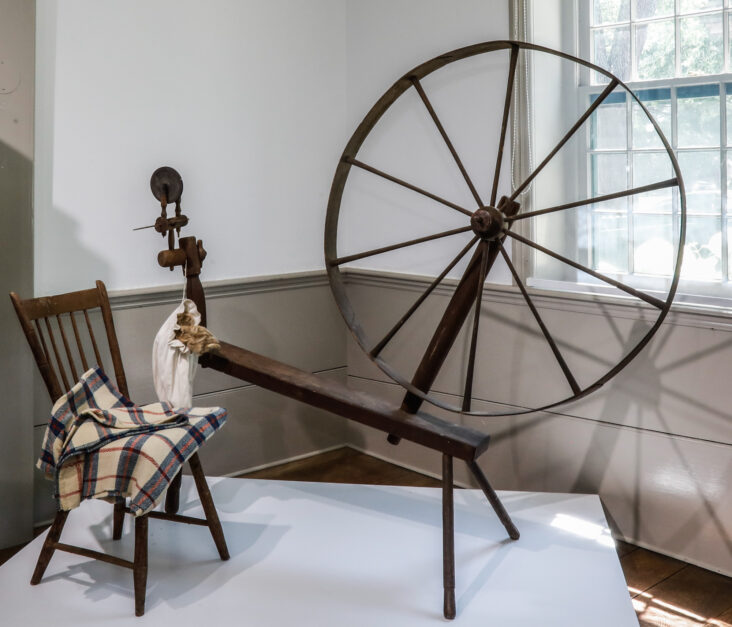
Wool Spinning Wheel, 1821
——————————————-
Made by Nathaniel Dominy V for Thomas Strong (1768-1846) and billed at 19 shillings. Strong was married to Rhoda Osborne (1774-1822) who would have spun sheep’s wool into yarn and thread for her family’s use. The spokes and the wheel rim are made of ash, the wheel was turned by a foot treadle (now missing.) Gift of Barbara Strong Borsack to the Historical Society.

Chest of Drawers 1817
On March 22, 1817, Nathaniel Dominy V accounts recorded “1 bureau £6, made for Jacob Hedges, Jr.” (1784—1869.) In September 1816, Hedges married Betsy Dimon (1794—1844) and was sprucing up the marital home at 77 Pantigo Road, which still stands today. Ranking #116 on the tax list in East Hampton, Hedges was not especially well-to-do. A chest of drawers was a practical necessity in an era when all clothing was folded or rolled. Clothes hangers were a much later Victorian-era invention.
The primary wood is walnut. The bureau was gifted to the Historical Society by the Hedges family.
Chairs in background: “Fiddleback” Armchair with Rockers, Circa 1800″ — Between 1796 and 1808, Nathaniel Dominy V made at least 31 chairs described as “fiddleback,” named for the violin-shaped back support.
Child’s Chair, 1801: Dominy accounts record “Chairs, small, made for Abraham Sherrill Jr., April 25th, 1801” the year his son, Stephen, was born. By 1809, Abraham (1754 – 1844), who had fought in the Revolution and his wife, Anna Huntting (1763 – 1847), had three children. Descended directly in the Sherrill family, donated by Mary Foster Morgan.
——————————————-
Chairs 1796 – 1814
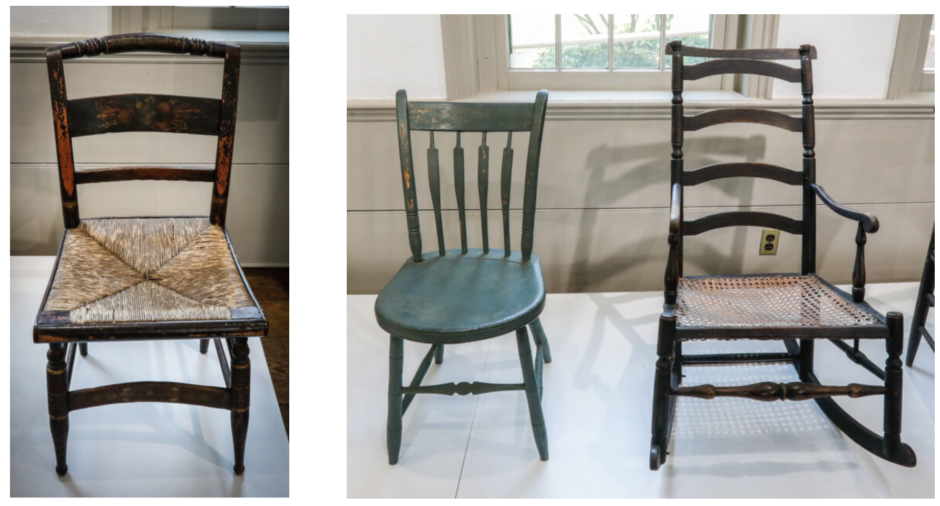
Fashions in furniture design slowly evolved over the decades even in remote rural East Hampton. Dominy accounts list 349 chairs between 1766 and 1833 that kept pace with their clients’ demand for the latest design.
——————————————-
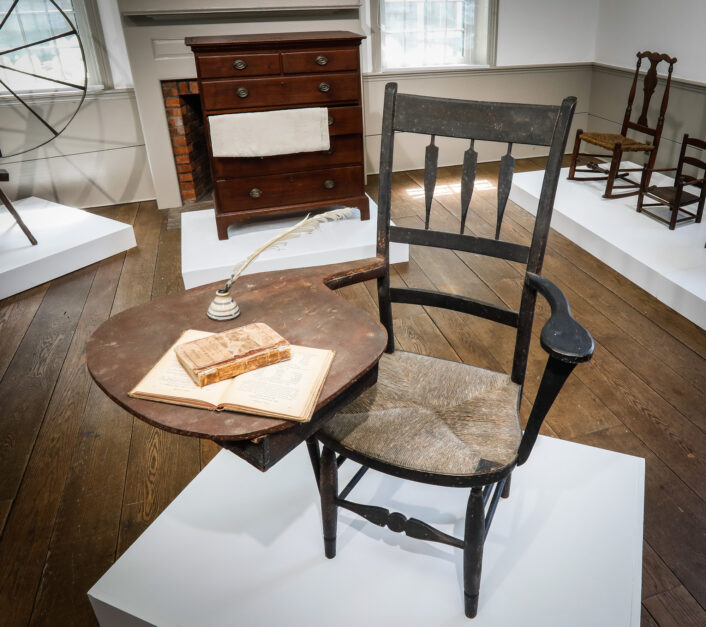
School Master’s Chair, 1804
Clinton Academy was built in 1784 as the first academy chartered in New York State. Uncommon for the time, it offered education for both young men and women. Recorded in Nathaniel Dominy V’s account book as “School House to Great Chair” at 13 shillings, this chair was likely made for the Clinton Academy schoolmaster. Comfortable with a soft rush seat and writing/bookshelf, the pupils sat on hard wooden benches facing their school master.
——————————————-

MADE TO ORDER — DOMINY CRAFTSMEN & THEIR CUSTOMERS
——————
NOTE THAT THE EXHIBIT ALSO CONTAINS
TOOLS & RELATED ITEMS NOT SHOWN IN THIS PORTFOLIO.
——————
Exhibit on Display at Clinton Academy, Weekdays through Labor Day weekend.
——————————–
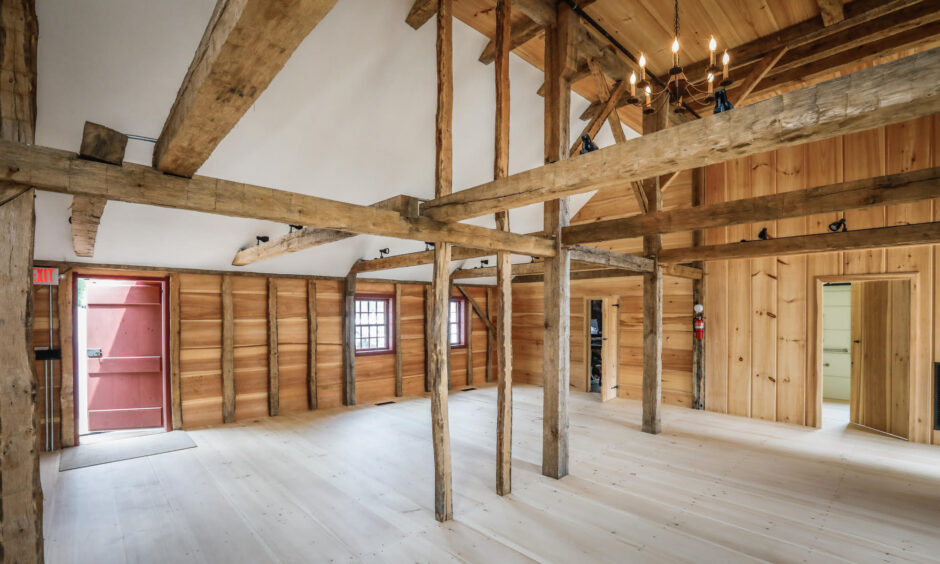
Visit: AAQ | Dominy House & Shops — The Restoration Portfolio: 2017 – 2023
——————————–
Model of Dominy House & Workshops built by Ralph Carpentier in 1982,
when he was the Executive Director of the Historical Society.
~~~~~~~~~~~~~~~~~~~~~~~~~~~~~~~~~~~

————————————————————

An exclusive AAQ Portfolio / Photographed by Jeff Heatley.
___________________________________________________________
